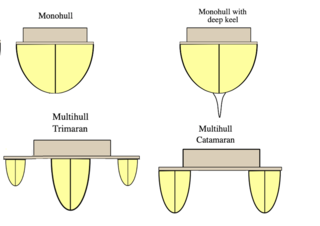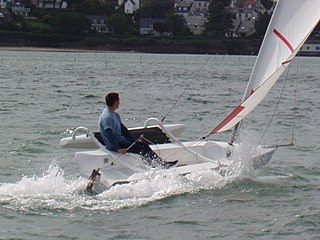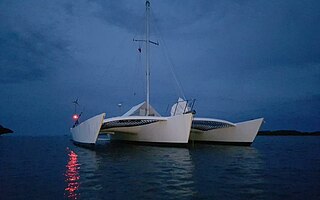Related Research Articles

A multihull is a boat or ship with more than one hull, whereas a vessel with a single hull is a monohull. The most common multihulls are catamarans, and trimarans. There are other types, with four or more hulls, but such examples are very rare and tend to be specialised for particular functions.

A sailboat or sailing boat is a boat propelled partly or entirely by sails and is smaller than a sailing ship. Distinctions in what constitutes a sailing boat and ship vary by region and maritime culture.

A catamaran is a multi-hulled watercraft featuring two parallel hulls of equal size. It is a geometry-stabilized craft, deriving its stability from its wide beam, rather than from a ballasted keel as with a monohull boat. Catamarans typically have less hull volume, smaller displacement, and shallower draft (draught) than monohulls of comparable length. The two hulls combined also often have a smaller hydrodynamic resistance than comparable monohulls, requiring less propulsive power from either sails or motors. The catamaran's wider stance on the water can reduce both heeling and wave-induced motion, as compared with a monohull, and can give reduced wakes.

A trimaran is a multihull boat that comprises a main hull and two smaller outrigger hulls which are attached to the main hull with lateral beams. Most modern trimarans are sailing yachts designed for recreation or racing; others are ferries or warships. They originated from the traditional double-outrigger hulls of the Austronesian cultures of Maritime Southeast Asia; particularly in the Philippines and Eastern Indonesia, where it remains the dominant hull design of traditional fishing boats. Double-outriggers are derived from the older catamaran and single-outrigger boat designs.

RMMV Oceanic was the planned name of an unfinished ocean liner that was partially built by Harland and Wolff for the White Star Line. It would have been the third ship bearing the name Oceanic, after the one of 1870 and the one of 1899. It was envisaged in 1926, with the idea of modernizing the transatlantic service of the company. With the arrival of Lord Kylsant at the head of the company, the planned size of the project increased, until it became that of a large ship destined to be the first to exceed the symbolic limit of 300 metres (984 ft) in length and 30 knots in speed.

Proas are various types of multi-hull outrigger sailboats of the Austronesian peoples. The terms were used for native Austronesian ships in European records during the Colonial era indiscriminately, and thus can confusingly refer to the double-ended single-outrigger boats of Oceania, the double-outrigger boats of Island Southeast Asia, and sometimes ships with no outriggers or sails at all.

Henk de Velde was a Dutch seafarer. He was especially known for his long solo-voyages around the world.
Arthur Piver was a World War II pilot, an amateur sailor, author, printshop owner and legendary boatbuilder who lived in Mill Valley on San Francisco Bay and became "the father of the modern multihull."

The Astus 14.1 is a 14 ft (4.18m) trimaran dinghy aimed at recreational sailing and racing. The trimaran design is unusual for a boat of this size but is said to combine the features of other types of design: pointing ability of a monohull dinghy, reaching ability of a catamaran, and planing ability of a skiff. The stability provided by the floats makes the boat accessible to beginners and single-handed racers.

Floats are airtight hollow structures, similar to pressure vessels, designed to provide buoyancy in water. Their principal applications are in watercraft hulls, aircraft floats, floating pier, pontoon rhinos, pontoon causeways, and marine engineering applications such as salvage.
VPLP design is a French-based naval architectural firm founded by Marc Van Peteghem and Vincent Lauriot-Prévost, responsible for designing some of the world's most innovative racing boats. Their designs presently hold many of the World Speed Sailing records.

The Wētā 4.4 Trimaran is a 4.4 metre sailing dinghy conceived and developed in New Zealand from 2001-2006 by Roger and Chris Kitchen and others with original drawings by TC Design's Tim Clissold.
Type 917 rescue ship (ARS) is a type of rescue and salvage ship developed by China for its People's Liberation Army Navy (PLAN). A total of two ships have entered service by mid-2014, and more units are planned. Type 917 is the first ship in PLAN to adopt a trimaran hull, and hence received NATO reporting name Dasan class, or 大三 in Chinese, which is short for Da-xing (大型) San-ti-chuan (三体船), meaning Large Trimaran.
Lock Crowther was an Australian multihull sailboat designer. He grew up in Bairnsdale in the East Gippsland region of Victoria. Though his first name was Lachlan by birth, he insisted on being called Lock or Lockie.
Chris White is an American multihull sailboat designer.

Neel 45 is a cruising trimaran designed by Joubert-Nivelt and produced by Neel Trimarans.

Jay Kantola was an American naval architect who is most known for his work designing multihull sailboats. He began designing multihulls in the 1960's. Kantola was an early proponent of a vessel construction technique called cold molding and cored construction. Cold molding involves bending strips of wood at room temperature to form a desired shape. The shape is then retained by gluing the wood together using epoxy. When the shaped construction is coated with layers of fiberglass saturated with epoxy, the final construct is termed a cored or composite construction. Kantola was one of several designers that worked closely with Meade Gougeon, Joel Gougeon, and Jan Gougeon. These brothers are collectively known as the Gougeon brothers. They also designed vessels and founded a line of epoxy products called West System.

The F-31 Sport Cruiser is a family of American trailerable trimaran sailboats that was designed by New Zealander Ian Farrier and first built in 1991.
The Hybrid Trimaran is a gas and wave-powered trimaran vessel under construction.
References
- 1 2 3 4 5 6 "Discovery 20".
- ↑ "Discovery 20 for sale" (PDF).
- ↑ "Discovering the Discovery 20 Small Trimaran".
- ↑ "Discovery 20". www.chriswhitedesigns.com. Retrieved 2023-01-28.
- ↑ "Small Trimarans: An Introduction".
- ↑ "Snapshots of a Discovery 20 Trimaran".